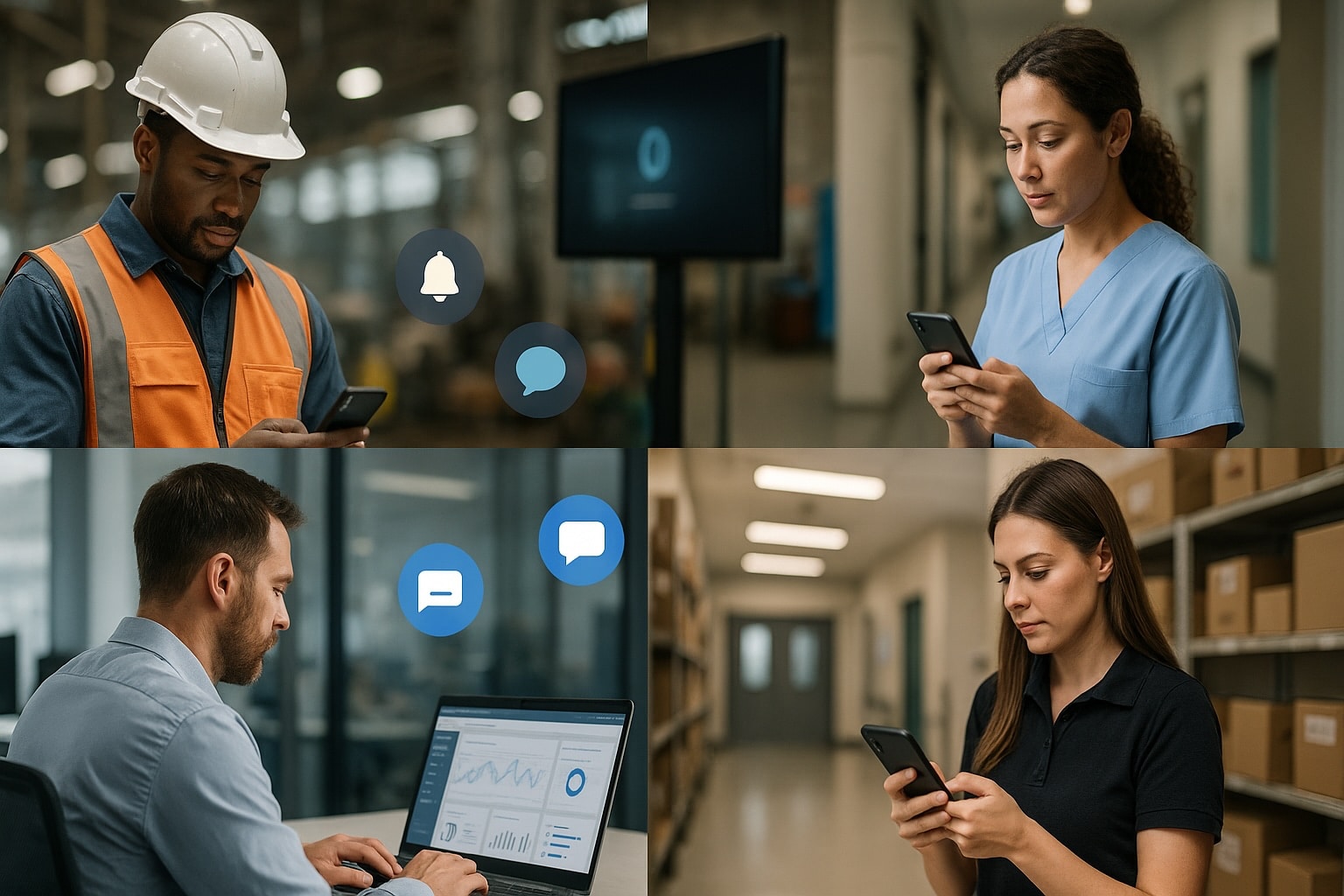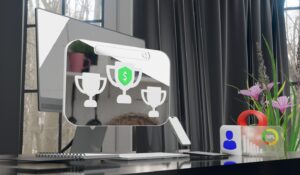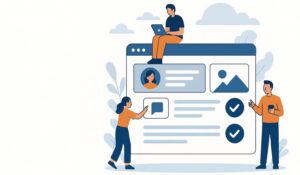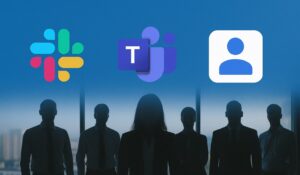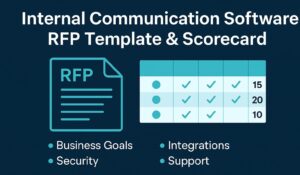Frontline employees are the heartbeat of industries like retail, manufacturing, transportation, and healthcare. Yet, they’re often the hardest to reach with timely, consistent communication. Unlike desk workers, frontline staff don’t spend their days checking email or logging into intranet portals. That’s why organizations need internal communication tools for frontline workers—purpose-built to deliver information across channels they actually use.
In this article, we’ll explore proven strategies and the best frontline communication software to bridge the “last mile” gap. We’ll also show how modern mobile workforce communication solutions can improve field employee engagement across industries. This piece is part of our broader Internal Communication Tools guide, where we dive into solutions for hybrid, remote, and frontline teams alike.
The “Last Mile” Communication Challenge
Frontline employees face unique barriers:
- Limited tech access: Only 23% of frontline workers have a corporate email account (Deloitte).
- Language diversity: In industries like manufacturing and hospitality, teams often span multiple languages.
- Shift-based work: Staff rotate across day, night, and weekend shifts, making it hard to share updates consistently.
- Safety & compliance stakes: In healthcare or production floors, missing critical instructions can put people at risk.
Traditional tools like intranets or mass emails fall short here. The challenge is ensuring communications are mobile-first, multilingual, and measurable—with proof that messages are seen, understood, and acted on. That’s why companies turn to modern frontline communication software built specifically for these needs.
Why Communication and Engagement Matter for Frontline Workers
Strong communication and engagement with frontline employees isn’t just “nice to have”—it directly impacts business performance. Research shows that companies with high employee engagement experience 21% greater profitability and 59% lower turnover (Gallup). Meanwhile, disengaged frontline employees can cost organizations millions in productivity loss.
For sectors like healthcare and manufacturing, engagement also influences safety, compliance, and service quality. A Harvard Business Review study found that engaged employees are more likely to adhere to safety protocols and customer service standards.
Platforms like HubEngage can improve engagement with gamification features—rewarding behaviors like completing training, acknowledging messages, or sharing feedback. By weaving gamification into mobile workforce communication, HubEngage helps improve field employee engagement and long-term retention.
Must-Have Features (Mobile, Multilingual, Read Receipts)
When selecting internal communication tools for frontline workers, prioritize these essentials:
- Mobile-first apps: Accessible on personal devices with offline capabilities.
- Push + SMS integration: Not all employees check apps daily, but 90% of text messages are read within 3 minutes (CTIA).
- Multilingual translation: Automatic translations help eliminate communication silos across diverse teams.
- Read receipts & acknowledgments: Ensures compliance with safety protocols and critical policy updates.
- Multi-channel delivery: Push, SMS, email, WhatsApp, Teams, Slack, and even digital signage for on-site employees.
This is where HubEngage stands out—with true multi-channel delivery that extends from push notifications to text messaging, email, Teams, Slack, WhatsApp, and on-location digital signage. For manufacturing floors or busy hospital units, this level of reach is critical.
Examples of Success in Different Industries
- Manufacturing: A leading auto parts manufacturer used digital signage paired with mobile push notifications to reduce missed shift updates by 65%.
- Retail: A big-box retailer deployed multilingual surveys to capture frontline sentiment, boosting employee engagement scores by 20% within six months (Retail Dive).
- Healthcare: A regional hospital network leveraged SMS alerts for critical staffing changes, cutting nurse absenteeism by 12% (Modern Healthcare).
These examples highlight that frontline success depends not only on the message but also on the frontline communication software that ensures staff receive, read, and respond.
Recommended Tools for Frontline Teams
Here’s a comparison of leading internal communication tools for frontline workers:
| Tool | Key Channels Supported | Best For | Limitation |
|---|---|---|---|
| HubEngage | Push, SMS, Email, WhatsApp, Teams, Slack, Digital Signage | Multi-industry, multi-channel frontline teams | None—covers full spectrum |
| Beekeeper | Mobile app + chat | Retail & hospitality | Limited signage/email |
| Blink | Mobile + chat | Field service | Weaker analytics |
| FirstUp | Email, app, intranet | Desk + hybrid workers | SMS not core focus |
HubEngage’s all-in-one reach across deskless and desk-based channels makes it ideal for large, distributed, and multilingual workforces.
AI Chatbots and Assistants: The New 24/7 Frontline Support
The rise of AI-powered assistants is transforming how frontline employees access information. Instead of waiting for manager responses or hunting through policy binders, workers can now ask a chatbot questions anytime, anywhere.
AI assistants streamline frontline communication by:
- Answering FAQs on policies, benefits, and procedures.
- Providing training content or safety checklists on-demand.
- Offering multi-language support with instant translations.
- Escalating urgent issues to managers automatically.
Platforms like HubEngage integrate AI chatbots directly into their communication hub, creating a 24/7 virtual assistant that reduces friction, saves time, and builds trust. This ensures employees always have access to the resources they need, whether it’s safety protocols in a factory or operating procedures in a hospital.
Engagement Tactics that Work
Technology alone isn’t enough. To build stronger field employee engagement, organizations should:
- Recognize publicly: Celebrate frontline wins through digital signage or mobile feeds.
- Use micro-surveys: Quick pulse checks on morale, safety, or workload.
- Push training snippets: Deliver micro-learning on safety or compliance directly to mobile devices.
- Leverage gamification: Award points for acknowledgments, surveys, or idea submissions.
- Segment messaging: Customize updates by role, location, or shift for relevance.
HubEngage’s gamification engine and real-time sentiment analysis make these tactics practical—helping frontline teams feel heard, valued, and motivated.
Conclusion
Effective frontline communication requires more than an app—it needs a multi-channel, measurable, and engaging strategy. From shift reminders and compliance alerts to recognition and morale-boosting surveys, the right tools ensure your frontline workers stay informed, safe, and connected.
HubEngage combines push notifications, SMS, email, WhatsApp, Teams, Slack, and digital signage into one streamlined system—helping HR, Ops, and Communications leaders eliminate silos and truly empower their frontline teams. Ready to reach every worker in minutes? See HubEngage in action with a personalized demo and discover how quickly you can transform frontline communication.
For a deeper dive into the broader landscape, explore our Internal Communication Software guide.
FAQs
How do you communicate effectively with frontline workers?
To communicate effectively, organizations need internal communication tools for frontline workers that are mobile-first, multilingual, and multi-channel. The best solutions deliver information through push notifications, SMS, WhatsApp, Teams, Slack, email, and even digital signage. By making communication concise, actionable, and always accessible, companies improve clarity, compliance, and frontline engagement.
What tools work best for field staff?
The best frontline communication software supports mobile workforce communication and real-time delivery. Platforms like HubEngage go beyond basic apps by combining push, SMS, email, WhatsApp, Teams, Slack, and digital signage. This ensures every frontline worker—whether in retail, healthcare, or manufacturing—receives critical updates and recognition no matter where they are.
How can you measure frontline engagement?
The most effective way to measure field employee engagement is through analytics built into your frontline communication software. Tools like HubEngage track read receipts, survey participation, feedback loops, and recognition activity. With sentiment analysis layered in, leaders gain real-time visibility into how engaged their frontline workers are—and can adjust communication strategies accordingly.

